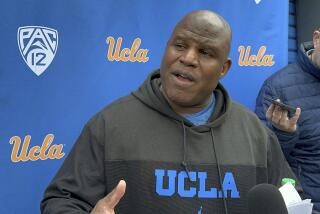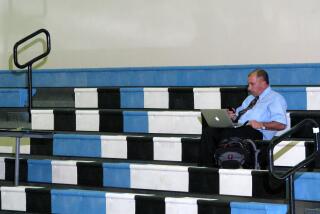Neumeierâs Scheme Not a Passing Fancy
CAMARILLO â Now, almost 30 years later, Jack Neumeier gets the credit he deserves.
The coach is retired, a decade removed from the game, but now he gets recognized for developing the wide-open passing attack that Washington State will throw at Michigan in the Rose Bowl today.
Quarterback Ryan Leaf and the Fab Five receiving corps are basically an updated version of the offense Neumeier created at Granada Hills High in 1970, a curious scheme that became known as âHappy Jackâs Flying Circus.â
A curious scheme that carried Granada Hills to a string of winning seasons and, along the way, was copied by teams across the country. It even showed up in Purdueâs 33-20 rout of Oklahoma State in the Alamo Bowl on Tuesday.
So now, Neumeier gets mentioned by big-time college coaches and gets written about in Sports Illustrated. He gets treated like some kind of genius.
Except, to hear him tell the story, his innovation wasnât so much genius as it was desperation.
The Granada Hills teams of the 1960s were slow and defensive-minded. They had some winning seasons, but Neumeier--entering his 10th year as head coach in 1970--knew that wasnât good enough.
âThat was going to be the end of my coaching career,â he said. âTen years and you havenât won a championship, give someone else a chance.â
As a last resort, he read about the new run-and-shoot and various spread formations that were just beginning to emerge from what was predominately a run-oriented game. Then he tinkered. This is what he drew up:
Two wideouts and two slot receivers. A single running back or sometimes a fifth receiver. A quarterback who can read defenses quickly and get rid of the ball even quicker.
The offense was designed to spread the defense thin, creating one-on-one pass coverage. If the cornerbacks lay off, throw quick slants.
âThe quarterback takes one step back and fires,â Neumeier said. âIf the receiver doesnât look up, the pass is going to hit him in the head.â
If the cornerbacks play close, burn them long. If the defense overloads its pass coverage, hit the seams with the running back.
âIt was a totally new concept,â said Darryl Stroh, an assistant who eventually succeeded Neumeier as head coach. âHe just went home over the summer and came back with this whole new flying circus thing.â
And all these years later, Leaf sounds eerily similar discussing his offensive philosophy.
âWe have five receivers,â the Washington State junior said. âYou canât guard âem all.â
Granada Hills unveiled its new offense against a Las Vegas team in the fall of 1970. The other team blitzed eight players on every play and pounded the Highlanders early.
Losing at halftime, Neumeier told his offensive linemen to treat pass protection as if it were run blocking.
âJust block the inside gaps,â he said. âForm a wall and fire out.â
No need to worry about outside blitzers. All the line needed to do was give the quarterback a couple of seconds to turn and throw.
âThe second half, we scored 38 points like it was nothing,â Neumeier recalled.
The Highlanders never let up. Quarterback Dana Potter passed for a then-City Section record of 3,214 yards while leading the team to the section championship that season. The offense was all the rage in Southern California.
âJack Neumeier was one of the innovators in the City,â former Banning Coach Chris Ferragamo told The Times in 1990. âHe was using four wide receivers and a single back and that was the thing of the future.â
Tom Ramsey, a Kennedy graduate who played quarterback for UCLA and the New England Patriots, recalled: âThey threw the ball 50 times a game. Now you really donât think that much of it, it happens so much. But then, it was kind of, âWow!â
âI remember one game they ran a double screen. That was the first time Iâd ever seen it. They had a screen on the left side, a screen on the right side and ended up throwing the ball to the outlet guy going across the middle. I said, âWow, theyâre really stretching the defense.â â
But Neumeierâs offense remained something of a local oddity until the mid-1970s, when John Elway enrolled at Granada Hills.
Elway was everything Neumeier could want: quick and smart, with a rocket launcher for an arm. He used the offense to become one of the top prep quarterbacks in the nation, passing for 5,701 yards and 49 touchdowns in 2 1/2 seasons.
His father, Jack, then the coach at Cal State Northridge, watched in amazement.
âI would sit in the stands taking notes all night,â Jack Elway told the Tacoma News Tribune. âIt was like a whole new world, seeing pass patterns so wide open, seeing the ball out so quickly . . . it was a defensive nightmare.â
Jack Elway instituted a version of it in his next job as coach at San Jose State. From there, Neumeierâs spread formation spread like wildfire.
Dennis Erickson, a San Jose assistant, brought it to Idaho. Another Elway colleague, Mike Price, brought it to Weber State. Price is now the coach at Washington State, where former assistant Joe Tiller learned enough of the offense to bring it to Purdue.
Today, Neumeierâs scheme can be seen on any field, on any weekend. Sports Illustrated this week calls it âa wide-open, pass-happy packageâ that âterrorized opponents.â
âItâs kind of surprising,â Neumeier said. âJack Elway could have said this was his offense, but he never did. He always gave me credit.â
Neumeier, 78, lives in Camarillo where he plays a little golf and watches a lot of football on television. He spent Tuesday night critiquing the Boilermakers.
âI thought the Oklahoma State corner was playing soft on their right end,â he said. â[Purdue] should have run more slants, more hitches.â
So it goes for the old coach. Just wait until the Rose Bowl game today. Neumeier tends to get agitated when he watches someone else run his offense.
âThere are still parts of it that no one does right,â he said. âEspecially when I see a receiver out there and nobody covering him close. Just take a step back and throw.
âYou ask my wife, I yell that all the time.â
More to Read
Go beyond the scoreboard
Get the latest on L.A.'s teams in the daily Sports Report newsletter.
You may occasionally receive promotional content from the Los Angeles Times.











